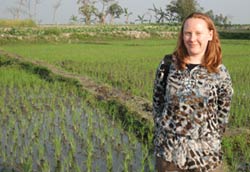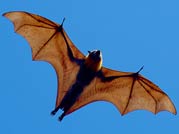RAPIDD program veteran tracks viruses transmitted by bats
May / June 2011 | Volume 10, Issue 3

Photo courtesy of Dr. Juliet Pulliam
Dr. Pulliam’s research in Malaysia confirmed
that virus-carrying bats were contaminating
sap from date palm trees.
By Steve Goldstein
Math modelers don’t usually get their feet wet or their boots muddy or spend time in the lab poring over virus samples. Dr. Juliet R. C. Pulliam of Fogarty’s RAPIDD program is the outlier. So when there was an outbreak of Nipah encephalitis in Bangladesh while Pulliam was visiting earlier this year, she headed into the field. As she’s fond of telling her students: “The real world is much messier than just dealing with equations!”
The real world is what the Research and Policy for Infectious Disease Dynamics program - RAPIDD - is all about. Managed by Fogarty’s Division of International Epidemiology and Population Studies and the Department of Homeland Security, which provides funding, RAPIDD is designed to improve standards in infectious disease modeling to better inform policy decisions.
Mathematical modeling is widely misunderstood as a predictive tool. “The aim of modeling is not to precisely predict but to compare strategies, clarify assumptions and identify gaps in knowledge,” said Fogarty senior scientist Dr. Ellis McKenzie, one of the founders and managers of RAPIDD. “So, if you’re someone responsible for combating an outbreak it’s a way of making more rational decisions about how the disease is going to act.”
As Pulliam noted, modeling is used in every branch of science. But it is particularly important for infectious diseases because a lot of the available data are observational, and it’s not practical to do experiments. “Models are a way of asking important questions without doing those experiments,” she explained.
Pulliam is highly skilled in this discipline. Finishing up her three-year stint as a RAPIDD program fellow, she was in Bangladesh working with collaborators at the International Center for Diarrheal Disease Research when the Nipah outbreak occurred. Pulliam headed into the field and took stock of the toll: 28 cases - all of them fatal - with many tied to consumption of raw sap from date palm trees. As in previous outbreaks, the sap was likely contaminated by virus-carrying bats - the large flying fox - who use the sap as a food source.

Photo courtesy of
University of North Carolina
What to do with the data? “One of the major questions is how transmissible the virus is and what are the conditions where we have to worry about it, other than just where infected bats are present,” said Pulliam. She and her fellow researchers will analyze the data to estimate the basic reproduction number of the virus, which is a quantity that is useful in determining how transmissible the virus is. To date, the value for Nipah transmission among people has been below one, so outbreaks are self-limiting.
Mathematical models can be used to assess which factors could increase the value above one - indicating the potential to produce large epidemics - and how likely this is under different scenarios.
Pulliam, who has a Ph.D. in ecology and evolutionary biology from Princeton University, has always been fascinated by viruses that jump species and has written several papers on the topic. McKenzie said she was an ideal candidate for the RAPIDD program. “She’s able to go back and forth between theoretical work and doing the muddy boots work. You find people really good at one part but not at several aspects,” he said.
In the fall, Pulliam will leave Fogarty for a faculty position at the University of Florida in their new Emerging Pathogens Institute. Recently, Pulliam traveled to South Africa, as she has for the past three years, instructing young African mathematicians in modeling of infectious diseases. She hopes it will give them a tool to address some of the challenges on the continent.
“There’s a huge amount of passion in these students,” she said. “They’ve grown up around the AIDS epidemic. They’ve experienced a lot of infectious diseases in their lives and now they realize they can use math to understand infectious disease spread. They have to learn to think across disciplines.”
More Information
To view Adobe PDF files,
download current, free accessible plug-ins from Adobe's website.